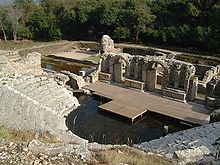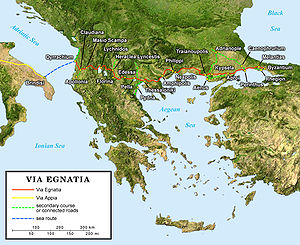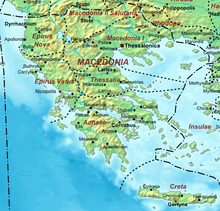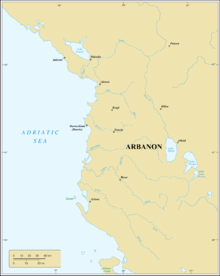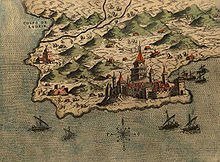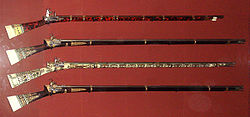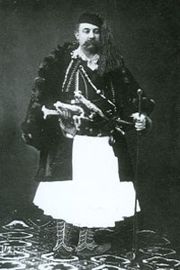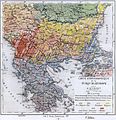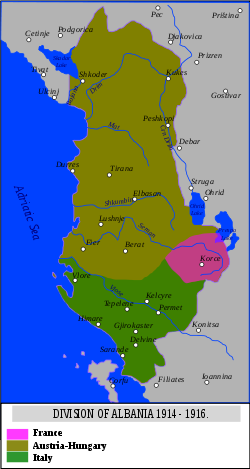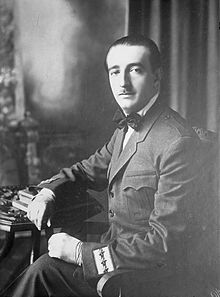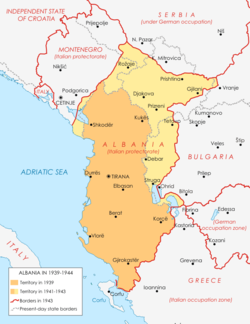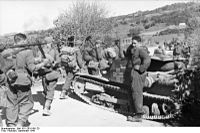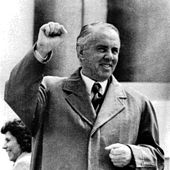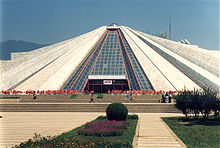- History of Albania
-
History of Albania 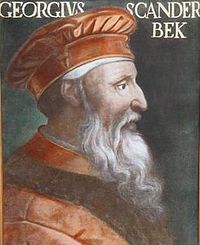 PrehistoryAntiquityMiddle AgesOttoman AlbaniaPost-IndependenceContemporary Albania
PrehistoryAntiquityMiddle AgesOttoman AlbaniaPost-IndependenceContemporary AlbaniaThe history of Albania emerges from the prehistoric stage from the 4th century BC, with early records of Illyria in Greco-Roman historiography. The modern territory of Albania has no counterpart in antiquity, comprising parts of the Roman provinces of Dalmatia (southern Illyricum), Macedonia (particularly Epirus Nova), and Moesia Superior. The territory remained under Roman (Byzantine) control until the Slavic migrations of the 7th century, and was integrated into the Bulgarian Empire in the 9th century.
The territorial nucleus of the Albanian state forms in the Middle Ages, as the Principality of Arbër and the Sicilian dependency known as the Kingdom of Albania. The first records of the Albanian people as a distinct ethnicity also date to this period. The area was conquered by the Serbian Empire, passing to the Ottoman Empire in 15th century. It remained under Ottoman control as part of the Rumelia province until 1912, when the first independent Albanian state was declared following the short occupation by Kingdom of Serbia.[1] The formation of an Albanian national consciousness dates to the later 19th century and is part of the larger phenomenon of rise of nationalism under the Ottoman Empire. A short-lived monarchy (1914–1925) was succeeded by an even shorter-lived first Albanian Republic (1925–1928), to be replaced by another monarchy (1928–1939), which was conquered into Fascist Italy during World War II. After the collapse of the Axis powers, Albania became a communist state, the Socialist People's Republic of Albania, which for the most part of its duration was dominated by Enver Hoxha (d. 1985). Hoxha's political heir Ramiz Alia oversaw the disintegration of the "Hoxhaist" state during the wider collapse of the Eastern Bloc in the later 1980s.
The communist regime collapsed in 1990, and the Republic of Albania was founded in 1991 and the former communist party was routed in elections March 1992, amid economic collapse and social unrest. Further crisis during the 1990s, peaking in the 1997 Lottery Uprising, led to mass emigration of Albanians, mostly to Italy, Greece, Switzerland, Germany and to North America during the 1990s. Albania became a full member of NATO in 2009. The country is applying to join the European Union.
Prehistory
The first traces of human presence in Albania were found in the village Xarrë, near Sarandë and Mount Dajt near Tiranë dating to the Middle Paleolithic and Upper Paleolithic eras.[2] The objects found in a cave near Xarrë include flint and jasper objects and fossilized animal bones, while those found at Mount Dajt comprise bone and stone tools similar to those of the Aurignacian culture. The Paeolithic finds of Albania show great similarities with objects of the same era found at Crvena Stijena in Montenegro and north-western Greece.[2]
During the Bronze Age, several artifacts from tumulus burials have been unearthed in central and southern Albania, showing close connection with sites in southwestern Macedonia and Lefkada, Greece. Archeologists have come to the conclusion that from the middle of the third millennium BC, these regions were inhabited by Indo-European people who spoke an early form of Greek. A part of them later moved to Mycenae around 1600 BC and founded the Mycenaean civilisation there.[3][4][5] On the other hand the Illirii, probably the southernmost Illyrian tribe of that time[6] that lived on the border of Albania and Montenegro, were possibly neighboring with the Greek tribes.[6][7] In the late Bronze Age and early Iron Age a number of possible population movements occurred, with the Bryges being settled in areas of southern Albania-northwestern Greece[8] and Illyrian tribes moved into central Albania.[5] The later derive from early Indo-European presence in western Balkan Peninsula. Their formation can be assumed to coincide with the beginning Iron Age in the Balkans, during the early 1st millennium BC.[9]
Archaeologists associate the Illyrians with the Hallstatt culture, an Iron Age people noted for production of iron, bronze swords with winged-shaped handles, and domestication of horses. It is impossible to delineate Illyrian tribes from Paleo-Balkans in a strict linguistic sense, but areas classically included under "Illyrian" for the Balkans Iron Age include the area of the Danube, Sava, and Morava rivers to the Adriatic Sea and the Shar Mountains.[10]
Antiquity
Illyrians
The territory of Albania in antiquity was mainly inhabited by Illyrian tribes,[11] who, like other ancient people, were subdivided into tribes and clans.[12] The region was also inhabited by Bryges,[13] a Phrygian people and the Chaones, an ancient Greek people.
The Illyrians (Ancient Greek: Ἰλλυριοί; Latin: Illyrii or Illyri) were a group of tribes who inhabited the Western Balkans during classical antiquity. The territory the tribes covered came to be known as Illyria to Hellenistic and Roman authors, corresponding roughly to the area between Adriatic sea in west, Drava river in North, Morava[disambiguation needed
 ] river in east and the mouth of Vjosë river in south.[14][15] The first account of Illyrian peoples comes from Periplus or Coastal passage an ancient Greek text of the middle of the 4th century BC.[16]
] river in east and the mouth of Vjosë river in south.[14][15] The first account of Illyrian peoples comes from Periplus or Coastal passage an ancient Greek text of the middle of the 4th century BC.[16]The Illyrian tribes that resided in the region of modern Albania were the Taulantii in central Albania[17] the Parthini, the Abri and the Caviii in the north, the Enchelei in the east,[18] the Bylliones in the south and several others. In the westernmost parts of the territory of Albania along with the Illyrian tribes lived the Bryges,[19] a Phrygian people, and in the south[20][21] lived the Greek tribe of the Chaonians.[19][22][23]
In the 4th century BC, the Illyrian king Bardyllis united several Illyrian tribes and engaged in conflict with Macedon to the southeast, but was defeated. Bardyllis was succeeded by Grabos,[24] then by Bardyllis II,[25] and then by Cleitus the Illyrian,[25] who was defeated by Alexander the Great. Later on, in 229 BC, Queen Teuta[26] of the Ardiaei clashed with the Romans and initiated the Illyrian Wars, which resulted in defeat and in the end of Illyrian independence by 168 BC, when King Gentius was defeated by a Roman army.
Greeks
Beginning in the 7th century BC, Greek colonies were established on the Illyrian coast. The most important were Apollonia, Avlona (modern-day Vlorë), Epidamnos (modern-day Durrës), and Lissus (modern-day Lezhë). The rediscovered Greek city of Buthrotum (Ancient Greek: Βουθρωτόν, Vouthrotón) (modern-day Butrint), a UNESCO World Heritage Site, is probably more significant today than it was when Julius Caesar used it as a provisions depot for his troops during his campaigns in the 1st century BC. At that time, it was considered an unimportant outpost, overshadowed by Apollonia and Epidamnos.[27]
Roman Era
Main articles: Macedonia (Roman province), Dalmatia (Roman province), Illyricum (Roman province), and Moesia SuperiorThe lands comprising modern-day Albania were incorporated into the Roman Empire as part of the province of Illyricum above the river Drin, and Roman Macedonia (specifically as Epirus Nova) below it. The western part of the Via Egnatia ran inside modern Albania, ending at Dyrrachium. Illyricum was later divided into the provinces of Dalmatia and Pannonia.
The Roman province of Illyricum or[28][29] Illyris Romana or Illyris Barbara or Illyria Barbara replaced most of the region of Illyria. It stretched from the Drilon River in modern Albania to Istria (Croatia) in the west and to the Sava River (Bosnia and Herzegovina) in the north. Salona (near modern Split in Croatia) functioned as its capital. The regions which it included changed through the centuries though a great part of ancient Illyria remained part of Illyricum. South Illyria became Epirus Nova, part of the Roman province of Macedonia. In 357 AD the region was part of the Praetorian prefecture of Illyricum one of four large praetorian prefectures into which the Late Roman Empire was divided. By 395 AD dioceses in which the region was divided were the Diocese of Dacia (as Pravealitana), and the Diocese of Macedonia (as Epirus Nova). Most of the region of modern Albania corresponds to the Epirus Nova.
Christianization
Christianity came to Epirus nova, then part of the Roman province of Macedonia.[30] Since the 1st and 2nd century AD, Christianity had become the established religion in Byzantium, supplanting pagan polytheism and eclipsing for the most part the humanistic world outlook and institutions inherited from the Greek and Roman civilizations.
When the Roman Empire was divided into eastern and western halves in AD 395, Illyria east of the Drinus River (Drina between Bosnia and Serbia), including the lands that now form Albania, were administered by the Eastern Empire but were ecclesiastically dependent on Rome. But, though the country was in the fold of Byzantium, Christians in the region remained under the jurisdiction of the Roman pope until 732. In that year the iconoclast Byzantine emperor Leo III, angered by archbishops of the region because they had supported Rome in the Iconoclastic Controversy, detached the church of the province from the Roman pope and placed it under the patriarch of Constantinople. When the Christian church split in 1054 between the East and Rome, the region of southern Albania retained its ties to Constantinople while the north reverted to the jurisdiction of Rome. This split in marked the first significant religious fragmentation of the country.
After the formation of the Slav principality of Dioclia (modern Montenegro), the metropolitan see of Bar was created in 1089, and dioceses in northern Albania (Shkodër, Ulcinj) became its suffragans. Starting in 1019, Albanian dioceses of the Byzantine rite were suffragans of the independent Archdiocese of Ohrid until Dyrrachion and Nicopolis, were re-established as metropolitan sees. Thereafter, only the dioceses in inner Albania (Elbasan, Krujë) remained attached to Ohrid. In the 13th century during the Venetian occupation, the Latin Archdiocese of Durrës was founded.
Middle Ages
Byzantine rule and barbarian invasions
Main article: Albania under the Byzantine EmpireAfter the region fell to the Romans in 168 BC it became part of Epirus nova that was in turn part of the Roman province of Macedonia. Later it was part of provinces of the Byzantine empire called Themes.
When the Roman Empire was divided into East and West in 395, the territories of modern Albania became part of the Byzantine Empire. Beginning in the first decades of Byzantine rule (until 461), the region suffered devastating raids by Visigoths, Huns, and Ostrogoths. In the 6th and 7th centuries, the region experienced an influx of Slavs.
The new administrative system of the themes, or military provinces created by the Byzantine Empire, contributed to the eventual rise of feudalism in Albania, as peasant soldiers who served military lords became serfs on their landed estates. Among the leading families of the Albanian feudal nobility were the Balsha, Thopia, Shpata, Muzaka, Dukagjini and Kastrioti. The first three of these rose to become rulers of principalities were vassals of the Byzantine Empire, maintaining a partial local autonomy from the Byzantine Empire. Many Albanians converted to the Roman Catholic Church at that period.
In the first decades under Byzantine rule (until 461), Epirus nova suffered the devastation of raids by Visigoths, Huns, and Ostrogoths. Not long after these barbarian invaders swept through the Balkans, the Slavs appeared. Between the 6th and 8th centuries they settled in Roman territories. In the 4th century, barbarian tribes began to prey upon the Roman Empire. The Germanic Goths and Asiatic Huns were the first to arrive, invading in mid-century; the Avars attacked in AD 570; and the Croatian tribes invaded in the early 7th century. In general, the invaders destroyed or weakened Roman and Byzantine cultural centers in the lands that would become Albania.[31]
Albania under the Bulgarian Empire
Main article: Albania under the Bulgarian EmpireIn the mid 9th century most of eastern Albania became part of the Bulgarian Empire. The area, known as Kutmichevitsa, became an important Bulgarian cultural center in 10th century with many thriving towns such as Devol, Glavinitsa (Ballsh) and Belgrad (Berat). When the Byzantines managed to conquer the First Bulgarian Empire the fortresses in eastern Albania were some of the last Bulgarian strongholds to be submitted by the Byzantines. Later the region was recovered by the Second Bulgarian Empire.
The first undisputed mention of Albanians in the historical record is attested in Byzantine source for the first time in 1079-1080, in a work titled History by Byzantine historian Michael Attaliates, who referred to the Albanoi as having taken part in a revolt against Constantinople in 1043 and to the Arbanitai as subjects of the duke of Dyrrachium. It is disputed, however, whether the "Albanoi" of the events of 1043 refers to Albanians in an ethnic sense or whether "Albanoi" is a reference to Normans from Sicily under an archaic name (there was also tribe of Italy by the name of "Albanoi").[34] However a later reference to Albanians from the same Attaliates, regarding the participation of Albanians in a rebellion around 1078, is undisputed.[35]
It was in 1190, when a local Albanian noble called Progon created the Principality of Arbër, with its capital at Krujë. After the fall of Progon Dynasty in 1216, the principality came under Grigor Kamona and Gulam of Albania. Finally the Principality was dissolved on 1255.
In 1271 Charles of Anjou after he captured Durrës from Despotate of Epirus, created the Kingdom of Albania. In 14th century a number of Albanian principalities were created.
Late Middle Ages
After the weakening of the Byzantine Empire and the Bulgarian Empire in the middle and late 13th century, most of the Albanian territory became part of the Serbian state. Firstly, as part of Rashka and later as part of Serbian Empire. The southern part was governed by the semi-independent, Serbian ruled Despotate of Epiros. Along with the Serbian ruled Albania, there was also an Albanian state, the Principality of Arbër, and later the Kingdom of Albania. These three entities, covers the history of Albania between the late 12th century, until the half of the 14th century, when Albanian Principalities were created through all Albania.
Serbian Empire
Main article: Albania under the Serbian EmpireThe Serbs occupied parts of northern and eastern Albania toward the end of the 12th century.
Principality of Arbër
Main article: Principality of ArbërIn 1190 the first Albanian medieval state, the Principality of Arbër was founded by the House of Progon with the city of Krujë as the capital. Progoni was succeeded by Gjini and then by Dhimiter.
In 1204, after Western crusaders sacked Constantinople, Venice won nominal control over Albania and the Epirus region of northern Greece and took possession of Durrës. During the Serbian Occupation the first Albanian state of the Middle Ages was created.[citation needed]
Anjou Kingdom of Albania
After the fall of the Principality of Arber in territories captured by the Despotate of Epiros, the Kingdom of Albania was established by Charles of Anjou. He took the title of King of Albania in February, 1272.
The Albanian principalities and the League of Lezhë
In 1368 the Kingdom of Albania was disestablished and several Albanian principalities were formed including the Princedom of Albania, the Principality of Dukagjini, the Principality of Kastrioti, the Principality of Gjirokastër and the Muzakaj Principality of Berat.
In the late 14th and the early 15th century the Ottoman Empire conquered parts of Albania.
The Albanians regained control of their territories in 1444 when the League of Lezhë was established, initially under the rule of George Kastrioti and after his death it was led by Lekë Dukagjini.
In the Middle Ages, the name Arberia (see Origin and history of the name Albania) began to be increasingly applied to the region now comprising the nation of Albania.
Ottoman rule
Main article: Ottoman AlbaniaOttoman supremacy in the west Balkan region began in 1385 with the Battle of Savra. On the conquered part of Albania, which territory stretched between Mat River on the north and Çameria to the south, Ottoman Empire established the Sanjak of Albania [36] and in 1419 Gjirokastra became the county town of the Sanjak of Albania.[37] Beginning in the late-14th century, the Ottomans expanded their empire from Anatolia to the Balkans (Rumelia). By the 15th century, the Ottomans ruled most of the Balkan Peninsula. Their rule in part of Albania was briefly interrupted in the 15th century, when George Kastrioti Skanderbeg, an Albanian who had served as an Ottoman military officer, renounced Ottoman service, allied with some Albanian chiefs and fought off Turkish rule from 1443-1478. Albania was fully re-occupied by the Ottomans in 1478.
Ottoman-Albanian wars
Many Albanians had been recruited into the Janissary, including the feudal heir George Kastrioti who was renamed Skanderbeg (Iskandar Bey) by his Turkish trainers at Edirne. After some Ottoman defeats at the hands of the Serbs, Skanderbeg deserted and began a rebellion against the Ottoman Empire.[38]
After deserting, Skanderbeg re-converted to Roman Catholicism and declared a holy war against the Ottoman Empire,[38] which he led from 1443 to 1468. Under a red flag bearing Skanderbeg's heraldic emblem, an Albanian force held off Ottoman campaigns for twenty-five years and overcame sieges of Krujë led by the forces of the Ottoman sultans Murad II and Mehmed II.
However, Skanderbeg was unable to receive any of the help which had been promised him by the popes. He died in 1468, leaving no worthy successor. After his death the rebellion continued, but without its former success. The loyalties and alliances created and nurtured by Skanderbeg faltered and fell apart and the Ottomans reconquered the territory of Albania in 1478. Shortly after the fall of Kruje's castle, some Albanians fled to neighboring Italy, giving rise to the modern Arbëreshë communities.
Late Ottoman period
Upon the Ottomans' return in 1478, a large number of Albanians fled to Italy, Greece and Egypt and maintained their Arbëresh identity. Many Albanians won fame and fortune as soldiers, administrators, and merchants in far-flung parts of the Empire. As the centuries passed, however, Ottoman rulers lost the capacity to command the loyalty of local pashas, which threatened stability in the region. The Ottoman rulers of the 19th century struggled to shore up central authority, introducing reforms aimed at harnessing unruly pashas and checking the spread of nationalist ideas. Albania would be a part of the Ottoman Empire until the early 20th century.
The Ottoman period that followed was characterized by a change in the landscape through a gradual modification of the settlements with the introduction of bazaars, military garrisons and mosques in many Albanian regions. Part of the Albanian population gradually converted to Islam, with many joining the Sufi Order of the Bektashi. Converting from Christianity to Islam brought considerable advantages, including access to Ottoman trade networks, bureaucratic positions and the army. As a result many Albanians came to serve in the elite Janissary and the administrative Devşirme system. Among these were important historical figures, including Iljaz Hoxha, Hamza Kastrioti, Davud Pasha, Zağanos Pasha, Köprülü Mehmed Pasha (head of the Köprülü family of Grand Viziers), the Bushati family, Sulejman Pasha, Edhem Pasha, Nezim Frakulla, Ali Pasha of Tepelena, Haxhi Shekreti, Hasan Zyko Kamberi, Ali Pasha of Gucia, Mehmet Ali ruler of Egypt[39] and Emin Pasha[citation needed].
Many Albanians gained prominent positions in the Ottoman government, Albanians highly active during the Ottoman era and leaders such as Ali Pasha of Tepelena might have aided Husein Gradaščević. The Albanians proved generally faithful to Ottoman rule following the end of the resistance led by Skanderbeg, and accepted Islam more easily than their neighbors.[40] No fewer than 42 Grand Viziers of the Empire were of Albanian descent. The Ottoman period also saw the rising of semi-autonomous Albanian ruled Pashaliks and Albanians were also an important part of the Ottoman army and Ottoman administration like the case of Köprülü family. Albania would remain a part of the Ottoman Empire as the provinces of Scutari, Monastir and Janina until 1912.
Birth of nationalism
By the 1870s, the Sublime Porte's reforms aimed at checking the Ottoman Empire's disintegration had clearly failed. The image of the "Turkish yoke" had become fixed in the nationalist mythologies and psyches of the empire's Balkan peoples, and their march toward independence quickened. The Albanians, because of the higher degree of Islamic influence, their internal social divisions, and the fear that they would lose their Albanian-populated lands to the emerging Balkan states—Serbia, Montenegro, Bulgaria, and Greece—were the last of the Balkan peoples to desire division from the Ottoman Empire.[41]
However, in the 19th century after the fall of the Albanian pashaliks and the Massacre of the Albanian Beys an Albanian National Awakening took place and many revolts against the Ottoman Empire were organized. Such revolts included the Albanian Revolts of 1833-1839, the Revolt of 1843-44, and the Revolt of 1847. A culmination of the Albanian National Awakening were the League of Prizren (1878–1881, with the backing of sultan Abdulhamid II) and the League of Peja, but they were unsuccessful to an Albanian independence, which occurred only in 1912, through the Albanian Declaration of Independence.
-
Ethnic composition map of the Balkans by the pro-Greek [42]
Independence of Albania (1912)
Main articles: Albania during the Balkan Wars, Albanian Declaration of Independence, and Provisional Government of AlbaniaThe initial sparks of the first Balkan War in 1912 were ignited by the Albanian uprising between 1908 and 1910[43] which were directed at opposing the Young Turk policies of consolidation of the Ottoman Empire. Following the eventual weakening of the Ottoman Empire in the Balkans, Serbia, Greece and Bulgaria declared war and sought to aggrandize their respective boundaries on the remaining territories of the Empire. Albania was thus invaded by Serbia in the north and Greece in the south, restricting the country to only a patch of land around the southern coastal city of Vlora. In 1912 Albania, still under foreign occupation, declared its independence and, with the aid of Austria-Hungary, the Great Powers drew its present borders. The territorial security of Albania was guaranteed by the Great Powers in the Treaty of London of 1913.
The border between Albania and its neighbors was delineated in 1913 following the dissolution of most of the Ottoman Empire's territories in the Balkans. The delineation of the new state's borders left a significant number of Albanian communities outside Albania. This population was largely divided between Montenegro and Serbia (which then included what is now Kosovo and the Republic of Macedonia). A substantial number of Albanians thus found themselves under Serbian rule. At the same time, an uprising in the country's south by local Greeks, led to the formation of the Autonomous Republic of Northern Epirus in the southern provinces (1914). After a period of political instability brought about by the First World War, the country adopted a republican form of government in 1920.[44] The territorial security of Albania was guaranteed by a League of Nations declaration of November 9, 1921, which entrusted the defense of that state to Italy.[45]
Principality of Albania
In supporting the independence of Albania, the Great Powers were assisted by Aubrey Herbert, a British MP who passionately advocated the Albanian cause in London. As a result, Herbert was offered the crown of Albania, but was dissuaded by the British Prime Minister, H. H. Asquith, from accepting. Instead the offer went to William of Wied, a German prince who accepted and became sovereign of the new Principality of Albania.[44]
The Principality was established on February 21, 1914. The Great Powers selected Prince William of Wied, a nephew of Queen Elisabeth of Romania to become the sovereign of the newly independent Albania. A formal offer was made by 18 Albanian delegates representing the 18 districts of Albania on February 21, 1914, an offer which he accepted. Outside of Albania William was styled prince, but in Albania he was referred to as Mbret (King) so as not to seem inferior to the King of Montenegro.
Prince William arrived in Albania at his provisional capital of Durrës on March 7, 1914 along with the Royal family. The security of Albania was to be provided by a Gendarmerie commanded by Dutch officers.
Internal revolts and foreign occupation during World War I
World War I interrupted all government activities in Albania, while the country was split in a number of regional governments.[41] Political chaos engulfed Albania after the outbreak of World War I. The Albanian people split along religious and tribal lines after the prince's departure. Muslims demanded a Muslim prince and looked to Turkey as the protector of the privileges they had enjoyed. Other Albanians looked to Italy and Serbia for support. Still others, including many beys and clan chiefs, recognized no superior authority.
Prince William left Albania on September 3, 1914 following a pan-Islamic revolt initiated by Essad Pasha and later taken over by Haji Kamil, the military commander of the Islamic Emirate of Albania centered in Tirana. William subsequently joined the German army and served on the Eastern Front, but never renounced his claim to the throne.
In the country's south, the local Greek population, revolted against the incorporation of the area into the new Albanian state and declared the Autonomous Republic of Northern Epirus at February 28.[46][47]
In late 1914, Greece occupied southern Albania, including Korçë and Gjirokastër. Italy occupied Vlorë, and Serbia and Montenegro occupied parts of northern Albania until a Central Powers offensive scattered the Serbian army, which was evacuated by the French to Thessaloniki. Austro-Hungarian and Bulgarian forces then occupied about two-thirds of the country (Bulgarian occupation of Albania).
Under the secret Treaty of London signed in April 1915, Triple Entente powers promised Italy that it would gain Vlorë (Valona) and nearby lands and a protectorate over Albania in exchange for entering the war against Austria-Hungary. Serbia and Montenegro were promised much of northern Albania, and Greece was promised much of the country's southern half. The treaty left a tiny Albanian state that would be represented by Italy in its relations with the other major powers. In September 1918, Entente forces broke through the Central Powers' lines north of Thessaloniki and within days Austro-Hungarian forces began to withdraw from Albania. When the war ended on November 11, 1918, Italy's army had occupied most of Albania; Serbia held much of the country's northern mountains; Greece occupied a sliver of land within Albania's 1913 borders; and French forces occupied Korçë and Shkodër as well as other regions with sizable Albanian populations such as Kosovo.
Projects of partition in 1919-1920
After World War I, Albania was still under the occupation of Serbian and Italian forces. It was a rebellion of the respective populations of Northern and Southern Albania that pushed back the Serbs and Italians behind the recognized borders of Albania.
Albania's political confusion continued in the wake of World War I. The country lacked a single recognized government, and Albanians feared, with justification, that Italy, Yugoslavia, and Greece would succeed in extinguishing Albania's independence and carve up the country. Italian forces controlled Albanian political activity in the areas they occupied. The Serbs, who largely dictated Yugoslavia's foreign policy after World War I, strove to take over northern Albania, and the Greeks sought to control southern Albania.
A delegation sent by a postwar Albanian National Assembly that met at Durrës in December 1918 defended Albanian interests at the Paris Peace Conference, but the conference denied Albania official representation. The National Assembly, anxious to keep Albania intact, expressed willingness to accept Italian protection and even an Italian prince as a ruler so long as it would mean Albania did not lose territory. Serbian troops conducted actions in Albanian-populated border areas, while Albanian guerrillas operated in both Serbia and Montenegro.
In January 1920, at the Paris Peace Conference, negotiators from France, Britain, and Greece agreed to divide Albania among Yugoslavia, Italy, and Greece as a diplomatic expedient aimed at finding a compromise solution to the territorial conflict between Italy and Yugoslavia. The deal was done behind the Albanians' backs and in the absence of a United States negotiator.
Members of a second Albanian National Assembly held at Lushnjë in January 1920 rejected the partition plan and warned that Albanians would take up arms to defend their country's independence[citation needed] and territorial integrity.[citation needed] The Lushnjë National Assembly appointed a four-man regency to rule the country. A bicameral parliament was also created, in which an elected lower chamber, the Chamber of Deputies (with one deputy for every 12,000 people in Albania and one for the Albanian community in the United States), appointed members of its own ranks to an upper chamber, the Senate. In February 1920, the government moved to Tirana, which became Albania's capital.
One month later, in March 1920, U.S. President Woodrow Wilson intervened to block the Paris agreement. The United States underscored its support for Albania's independence by recognizing an official Albanian representative to Washington, and in December the League of Nations recognized Albania's sovereignty by admitting it as a full member. The country's borders, however, remained unsettled.
Albania achieved a degree of statehood after World War I, in part because of the diplomatic intercession of the United States. The country suffered from a debilitating lack of economic and social development, however, and its first years of independence were fraught with political instability. Unable to survive a predatory environment without a foreign protector, Albania became the object of tensions between Italy and the Kingdom of Serbs, Croats and Slovenes, which both sought to dominate the country.[48]
First Zogu Government (1922-1924)
Interwar Albanian governments appeared and disappeared in rapid succession. Between July and December 1921 alone, the premiership changed hands five times. The Popular Party's head, Xhafer Ypi, formed a government in December 1921 with Fan S. Noli as foreign minister and Ahmed Bey Zogu as internal affairs minister, but Noli resigned soon after Zogu resorted to repression in an attempt to disarm the lowland Albanians despite the fact that bearing arms was a traditional custom.
When the government's enemies attacked Tirana in early 1922, Zogu stayed in the capital and, with the support of the British ambassador, repulsed the assault. He took over the premiership later in the year and turned his back on the Popular Party by announcing his engagement to the daughter of the Progressive Party leader, Shefqet Verlaci.
Zogu's protégés organized themselves into the Government Party. Noli and other Western-oriented leaders formed the Opposition Party of Democrats, which attracted all of Zogu's many personal enemies, ideological opponents, and people left unrewarded by his political machine. Ideologically, the Democrats included a broad sweep of people who advocated everything from conservative Islam to Noli's dreams of rapid modernization.
Opposition to Zogu was formidable[citation needed]. Orthodox peasants in Albania's southern lowlands loathed Zogu[citation needed] because he supported the Muslim landowners' efforts to block land reform; Shkodër's citizens felt shortchanged because their city did not become Albania's capital, and nationalists were dissatisfied because Zogu's government did not press Albania's claims to Kosovo or speak up more energetically for the rights of the ethnic Albanian minorities in present-day Yugoslavia and Greece.
Zogu's party handily won elections for a National Assembly in early 1924[citation needed]. Zogu soon stepped aside, however, handing over the premiership to Verlaci in the wake of a financial scandal[citation needed] and an assassination attempt by a young radical that left Zogu wounded. The opposition withdrew from the assembly after the leader of a radical youth organization, Avni Rustemi, was murdered in the street outside the parliament building.
Noli Revolution (1924)
Noli's supporters blamed the Rustemi murder on Zogu's Mati clansmen, who continued to practice blood vengeance. After the walkout, discontent mounted, and in June 1924 a peasant-backed insurgency had won control of Tirana. Noli became prime minister, and Zogu fled to Yugoslavia.
Fan Noli, an idealist, rejected demands for new elections on the grounds that Albania needed a "paternal" government. In a manifesto describing his government's program, Noli called for abolishing feudalism, resisting Italian domination, and establishing a Western-style constitutional government. Scaling back the bureaucracy, strengthening local government, assisting peasants, throwing Albania open to foreign investment, and improving the country's bleak transportation, public health, and education facilities filled out the Noli government's overly ambitious agenda. Noli encountered resistance to his program from people who had helped him oust Zogu, and he never attracted the foreign aid necessary to carry out his reform plans. Noli criticized the League of Nations for failing to settle the threat facing Albania on its land borders.
Under Fan Noli, the government set up a special tribunal that passed death sentences, in absentia, on Zogu, Verlaci, and others and confiscated their property. In Yugoslavia Zogu recruited a mercenary army, and Belgrade furnished the Albanian leader with weapons, about 1,000 Yugoslav army regulars, and Russian White Emigres to mount an invasion that the Serbs hoped would bring them disputed areas along the border. After Noli's regime decided to establish diplomatic relations with the Soviet Union, a bitter enemy of the Serbian ruling family, Belgrade began making wild allegations that the Albanian regime was about to embrace Bolshevism. On December 13, 1924, Zogu's Yugoslav-backed army crossed into Albanian territory. By Christmas Eve, Zogu had reclaimed the capital, and Noli and his government had fled to Italy. But his government lasted just 6 months, and Ahmet Zogu returned with another coup d’état and regained the control, changing the political situation and abolishing principality.
Albanian Republic (1924-1928)
In late 1924 Ahmed Bey Zogu, then Albanian founding father and politician emerged victorious from an internal political power struggle against Prime Minister Fan Noli using Yugoslav military assistance.
After defeating Fan Noli`s government, Ahmet Zogu recalled the parliament, in order to find a solution for the uncrowned principality of Albania. The parliament quickly adopted a new constitution, proclaimed Albania a republic, and granted Zogu dictatorial powers that allowed him to appoint and dismiss ministers, veto legislation, and name all major administrative personnel and a third of the Senate. The Constitution provided for a parliamentary republic with a powerful president serving as head of state and government. Ahmet Zogu was elected president for a term of seven years by the National Assembly, prior to his proclamation King of Albanians. On January 31, Zogu was elected president for a seven-year term. Opposition parties and civil liberties disappeared; opponents of the regime were murdered; and the press suffered strict censorship. Zogu ruled Albania using four military governors responsible to him alone. He appointed clan chieftains as reserve army officers who were kept on call to protect the regime against domestic or foreign threats.
Zogu, however, quickly turned his back on Belgrade and looked instead to Benito Mussolini's Italy for patronage.[48] Under Zogu, Albania joined the Italian coalition against Yugoslavia of Kingdom of Italy, Hungary, and Bulgaria in 1924-1927. After the United Kingdom's and France's political intervention in 1927 with the Kingdom of Yugoslavia, the alliance crumbled. Zogu maintained good relations with Benito Mussolini's fascist regime in Italy and supported Italy's foreign policy. He would be the first and only Albanian to hold the title of president until 1991.
Kingdom of Albania (1928-1939)
In 1928 the country's parliament declared Albania a kingdom with Zogu as King.[48] King Zog remained a conservative, but initiated reforms. For example, in an attempt at social modernisation the custom of adding one's region to one's name was dropped. Zog also made donations of land to international organisations for the building of schools and hospitals.[49]
In 1928 Zogu secured the parliament's consent to its own dissolution. A new constituent assembly amended the constitution, making Albania a kingdom and transforming Zogu into Zog I, "King of the Albanians." International recognition arrived forthwith. The new constitution abolished the Albanian Senate, creating a unicameral National Assembly, but King Zog retained the dictatorial powers he had enjoyed as President.
Soon after his coronation, Zog broke off his engagement to Shefqet Verlaci's daughter, and Verlaci withdrew his support for the king and began plotting against him. Zog had accumulated a great number of enemies over the years, and the Albanian tradition of blood vengeance required them to try to kill him. Zog surrounded himself with guards and rarely appeared in public[citation needed]. The king's loyalists disarmed all of Albania's tribes except for his own Mati tribesmen and their allies[citation needed], the Dibra. Nevertheless, on a visit to Vienna in 1931, Zog and his bodyguards fought a gun battle with would-be assassins on the Opera House steps.
Zog remained sensitive to steadily mounting disillusion with Italy's domination of Albania. The Albanian army, though always less than 15,000-strong, sapped the country's funds, and the Italians' monopoly on training the armed forces rankled public opinion. As a counterweight, Zog kept British officers in the Gendarmerie despite strong Italian pressure to remove them. In 1931 Zog openly stood up to the Italians, refusing to renew the 1926 First Treaty of Tirana.
In 1932 and 1933, Albania could not make the interest payments on its loans from the Society for the Economic Development of Albania. In response, Rome turned up the pressure, demanding that Tirana name Italians to direct the Gendarmerie; join Italy in a customs union; grant Italy control of the country's sugar, telegraph, and electrical monopolies; teach the Italian language in all Albanian schools; and admit Italian colonists. Zog refused. Instead, he ordered the national budget slashed by 30 percent, dismissed the Italian military advisers, and nationalized Italian-run Roman Catholic schools in the northern part of the country.
By June 1934, Albania had signed trade agreements with Yugoslavia and Greece, and Mussolini had suspended all payments to Tirana. An Italian attempt to intimidate the Albanians by sending a fleet of warships to Albania failed because the Albanians only allowed the forces to land unarmed. Mussolini then attempted to buy off the Albanians. In 1935 he presented the Albanian government 3 million gold francs as a gift.
Zog's success in defeating two local rebellions convinced Mussolini that the Italians had to reach a new agreement with the Albanian king. A government of young men led by Mehdi Frasheri, an enlightened Bektashi administrator, won a commitment from Italy to fulfill financial promises that Mussolini had made to Albania and to grant new loans for harbor improvements at Durrës and other projects that kept the Albanian government afloat. Soon Italians began taking positions in Albania's civil service, and Italian settlers were allowed into the country.
Mussolini's forces overthrew King Zog when Italy invaded Albania in 1939.[48]
Albania during World War II
Starting in 1928, but especially during the Great Depression, the government of King Zog, which brought law and order to the country, began to cede Albania's sovereignty to Italy. Despite some insignificant resistance, especially at Durrës, Italy invaded Albania on 7 April 1939 and took control of the country, with the Italian Fascist dictator Benito Mussolini proclaiming Italy's figurehead King Victor Emmanuel III of Italy as King of Albania. The nation thus became one of the first to be occupied by the Axis Powers in World War II.[50]
As Hitler began his aggressions, Mussolini decided to occupy Albania as a means to compete with Hitler's territorial gains. Mussolini and the Italian Fascists saw Albania as a historical part of the Roman Empire, and the occupation was intended to fulfill Mussolini's dream of creating an Italian Empire. During the Italian occupation, Albania's population was subject to a policy of forced Italianization by the kingdom's Italian governors, in which the use of the Albanian language was discouraged in schools while the Italian language was promoted. At the same time, the colonization of Albania by Italians was encouraged.
Mussolini, in October 1940, used his Albanian base to launch an attack on Greece, which led to the defeat of the Italian forces and the Greek occupation of Southern Albania in what was seen by the Greeks as the liberation of Northern Epirus. While preparing for the Invasion of Russia, Hitler decided to attack Greece in December 1940 to prevent a British attack on his southern flank.[51]
Italian penetration in Albania
Albania had long had considerable strategic importance for Italy. Italian naval strategists eyed the port of Vlorë and the island of Sazan at the entrance to the Bay of Vlorë with considerable interest, as it would give Italy control of the entrance to the Adriatic Sea.[52] In addition, Albania could provide Italy with a beachhead in the Balkans. Before World War I Italy and Austria-Hungary had been instrumental in the creation of an independent Albanian state. At the outbreak of war, Italy had seized the chance to occupy the southern half of Albania, to avoid it being captured by the Austro-Hungarians. That success did not last long, as post-war domestic problems, Albanian resistance, and pressure from United States President Woodrow Wilson, forced Italy to pull out in 1920.[53]
When Mussolini took power in Italy he turned with renewed interest to Albania. Italy began penetration of Albania's economy in 1925, when Albania agreed to allow it to exploit its mineral resources.[54] That was followed by the First Treaty of Tirana in 1926 and the Second Treaty of Tirana in 1927, whereby Italy and Albania entered into a defensive alliance.[54] The Albanian government and economy were subsidised by Italian loans, the Albanian army was trained by Italian military instructors, and Italian colonial settlement was encouraged. Despite strong Italian influence, Zog refused to completely give in to Italian pressure.[55] In 1931 he openly stood up to the Italians, refusing to renew the 1926 Treaty of Tirana. After Albania signed trade agreements with Yugoslavia and Greece in 1934, Mussolini made a failed attempt to intimidate the Albanians by sending a fleet of warships to Albania.[56]
As Nazi Germany annexed Austria and moved against Czechoslovakia, Italy saw itself becoming a second-rate member of the Axis.[57] The imminent birth of an Albanian royal child meanwhile threatened to give Zog a lasting dynasty. After Hitler invaded Czechoslovakia (March 15, 1939) without notifying Mussolini in advance, the Italian dictator decided to proceed with his own annexation of Albania. Italy's King Victor Emmanuel III criticized the plan to take Albania as an unnecessary risk. Rome, however, delivered Tirana an ultimatum on March 25, 1939, demanding that it accede to Italy's occupation of Albania. Zog refused to accept money in exchange for countenancing a full Italian takeover and colonization of Albania.
Italian invasion
On April 7 Mussolini's troops invaded Albania. The operation was led by General Alfredo Guzzoni. The invasion force was divided into three groups, which were to land successively. The most important was the first group, which was divided in four columns, each assigned to a landing area at a harbor and an inland target on which to advance. Despite some stubborn resistance by some patriots, especially at Durrës, the Italians made short work of the Albanians.[57] Durrës was captured on April 7, Tirana the following day, Shkodër and Gjirokastër on April 9, and almost the entire country by April 10.
Unwilling to become an Italian puppet, King Zog, his wife, Queen Geraldine Apponyi, and their infant son Leka fled to Greece and eventually to London. On April 12, the Albanian parliament voted to depose Zog and unite the nation with Italy "in personal union" by offering the Albanian crown to Victor Emmanuel III.[58] The parliament elected Albania's largest landowner, Shefqet Bej Verlaci, as Prime Minister. Verlaci additionally served as head of state for five days until Victor Emmanuel III formally accepted the Albanian crown in a ceremony at the Quirinale palace in Rome. Victor Emmanuel III appointed Francesco Jacomoni di San Savino, a former ambassador to Albania, to represent him in Albania as "Lieutenant-General of the King" (effectively a viceroy).
Albania under Italy
While Victor Emmanuel ruled as king, Shefqet Bej Verlaci served as the Prime Minister. Shefqet Verlaci controlled the day to day activities of the Italian protectorate. On 3 December 1941, Shefqet Bej Verlaci was replaced as Prime Minister and Head of State by Mustafa Merlika Kruja.[59]
From the start, Albanian foreign affairs, customs, as well as natural resources came under direct control of Italy. The puppet Albanian Fascist Party became the ruling party of the country and the Fascists allowed Italian citizens to settle in Albania and to own land so that they could gradually transform it into Italian soil.
In October 1940, during the Greco-Italian War, Albania served as a staging-area for Italian dictator Benito Mussolini's unsuccessful invasion of Greece. Mussolini planned to invade Greece and other countries like Yugoslavia in the area to give Italy territorial control of most of the Mediterranean Sea coastline, as part of the Fascists objective of creating the objective of Mare Nostrum ("Our Sea") in which Italy would dominate the Mediterranean.
But, soon after the Italian invasion, the Greeks counter-attacked and a sizeable portion of Albania was in Greek hands (including the cities of Gjirokastër and Korçë). In April 1941, after Greece capitulated to the German forces, the Greek territorial gains in southern Albania returned to Italian command. Under Italian command came also large areas of Greece after the successful German invasion of Greece.
After the fall of Yugoslavia and Greece in April 1941, the Italian Fascists added to the territory of the Kingdom of Albania most of the Albanian-inhabited areas that had been previously given to the Kingdom of Yugoslavia. The Albanian fascists claimed in May 1941 that nearly all the Albanian populated territories were united to Albania (see map). Even areas of northern Greece (Chameria) were administered by Albanians[citation needed]. But this was even a consequence of borders that Italy and Germany agreed on when dividing their spheres of influence. Some small portions of territories with Albanian majority remained outside the new borders and contact between the two parts was practically impossible: the Albanian population under the Bulgarian rule was heavily oppressed.
Albania under Germany
After the surrender of the Italian Army in September 1943, Albania was occupied by the Germans and soon exploded into a ferocious guerilla war.
With the collapse of the Mussolini government in line with the Allied invasion of Italy, Germany occupied Albania in September 1943, dropping paratroopers into Tirana before the Albanian guerrillas could take the capital. The German Army soon drove the guerrillas into the hills and to the south. The Nazi German government subsequently announced it would recognize the independence of a neutral Albania and set about organizing a new government, police and armed forces. The Germans did not exert heavy-handed control over Albania's administration. Rather, they sought to gain popular support by backing causes popular with Albanians, especially the annexation of Kosovo. Many Balli Kombëtar units cooperated with the Germans against the communists and several Balli Kombëtar leaders held positions in the German-sponsored regime. Albanian collaborators, especially the Skanderbeg SS Division, also expelled and killed Serbs living in Kosovo.
In December 1943, a third resistance organization, an anticommunist, anti-German royalist group known as Legaliteti, took shape in Albania's northern mountains. Led by Abaz Kupi, it largely consisted of Geg guerrillas, supplied mainly with weapons from the allies, who withdrew their support for the NLM after the communists renounced Albania's claims on Kosovo.
The communist partizans entirely liberated Albania from German occupation on November 29, 1944, pursuing the German army till Višegrad, Bosnia (then Yugoslavia) in collaboration with the Yugoslav communist forces. The Albanian partisans also liberated Kosovo, part of Montenegro, and southern Bosnia and Herzegovina. By November 1944, they had thrown out the Germans, being with Yugoslavia the only East European nations to do so without any assistance from the Soviet Army. Enver Hoxha became the leader of the country by virtue of his position as Secretary General of the Albanian Communist Party. After having taken over power of the country, the Albanian communists launched a tremendous terror campaign, shooting intellectuals and arresting thousands of innocent people. Some died due to suffering torture.[citation needed]
Albania was one of the European countries occupied by the Axis powers that ended World War II with a larger Jewish population than before the war.[60][61][62][63] Some 1,200 Jewish residents and refugees from other Balkan countries were hidden by Albanian families during World War II, according to official records.[64]
Albanian resistance in World War II
The National Liberation War of the Albanian people started with the Italian invasion in Albanian on April 7, 1939 and ended on November 28, 1944. During the antifascist national liberation war, the Albanian people fought against Italy and Germany, which occupied the country. In the 1939-1941 period, the antifascist resistance was led by the National Front nationalist groups and later by the Communist Party.
Communist resistance
In October 1941, the small Albanian communist groups established in Tirana an Albanian Communist Party of 130 members under the leadership of Hoxha and an eleven-man Central Committee. The Albanian communists supported the Ribbentrop-Molotov pact, and did not participate in the antifascist struggle until Germany invaded the Soviet Union in 1941. The party at first had little mass appeal, and even its youth organization netted few recruits. In mid-1942, however, party leaders increased their popularity by calling the young peoples to fight for the liberation of their country, that was occupied by Fascist Italy. This propaganda increased the number of new recruits by many young peoples eager for freedom. In September 1942, the party organized a popular front organization, the National Liberation Movement (NLM), from a number of resistance groups, including several that were strongly anticommunist. During the war, the NLM's communist-dominated partisans, in the form of the National Liberation Army, did not heed warnings from the Italian occupiers that there would be reprisals for guerrilla attacks. Partisan leaders, on the contrary, counted on using the lust for revenge such reprisals would elicit to win recruits.
The communists turned the so-called war of liberation into a civil war, especially after the discovery of the Dalmazzo-Kelcyra protocol, signed by the Balli Kombetar. With the intention of organizing a partisan resistance, they called a general conference in Pezë on 16 September 1942 where the Albanian National Liberation Front was set up. The Front included nationalist groups, but it was dominated by communist partisans.
In December 1942, more Albanian nationalist groups were organized. Albanians fought against the Italians while, during Nazi German occupation, Balli Kombëtar allied itself with the Germans and clashed with Albanian communists, which continued their fight against Germans and Balli Kombëtar at the same time.
Nationalist resistance
A nationalist resistance to the Italian occupiers emerged in October 1942. Ali Klissura and Midhat Frashëri formed the Western-oriented and anticommunist Balli Kombëtar (National Front), Balli Kombetar collaborated with Nazi-Germany, a movement that recruited supporters from both the large landowners and peasantry. The Balli Kombëtar opposed King Zog's return and called for the creation of a republic and the introduction of some economic and social reforms. The Balli Kombëtar's leaders acted conservatively, however, fearing that the occupiers would carry out reprisals against them or confiscate the landowners' estates. The nationalistic Geg chieftains and the Tosk landowners often came to terms with the Italians, and later the Germans, to prevent the loss of their wealth and power.
Communist takeover of Albania
Provisional Communist administration
The communist partisans regrouped and gained control of southern Albania in January 1944. In May they called a congress of members of the National Liberation Front (NLF), as the movement was by then called) at Përmet, which chose an Anti-Fascist Council of National Liberation to act as Albania's administration and legislature. Hoxha became the chairman of the council's executive committee and the National Liberation Army's supreme commander. The communist partisans defeated the last Balli Kombëtar forces in southern Albania by mid-summer 1944 and encountered only scattered resistance from the Balli Kombëtar and Legality when they entered central and northern Albania by the end of July. The British military mission urged the remnants of the nationalists not to oppose the communists' advance, and the Allies evacuated Kupi to Italy. Before the end of November, the main German troops had withdrawn from Tirana, and the communists took control of the capital by fighting what was left from the German army. A provisional government the communists had formed at Berat in October administered Albania with Enver Hoxha as prime minister.
The consequences of the war
Albania stood in an unenviable position after World War II. Greece and Yugoslavia hungered for Albanian lands they claimed[citation needed]. The NLF's strong links with Yugoslavia's communists, who also enjoyed British military and diplomatic support, guaranteed that Belgrade would play a key role in Albania's postwar order. The Allies never recognized an Albanian government in exile or King Zog, nor did they ever raise the question of Albania or its borders at any of the major wartime conferences. No reliable statistics on Albania's wartime losses exist, but the United Nations Relief and Rehabilitation Administration reported about 30,000 Albanian war dead, 200 destroyed villages, 18,000 destroyed houses, and about 100,000 people left homeless. Albanian official statistics claim somewhat higher losses.
Furthermore, thousands of Chams (Tsams, Albanians living in Northern Greece) were driven out of Greece with the justification that they had collaborated with the Nazis.
Communist Albania
A collection of communists moved quickly after World War II to subdue all potential political enemies in Albania, break the country's landowners and minuscule middle class, and isolate Albania from the noncommunist world in order to establish the People's Republic of Albania. By early 1945, the communists had liquidated, discredited, or driven into exile most of the country's interwar elite. The internal affairs minister, Koçi Xoxe, a pro-Yugoslav erstwhile tinsmith, presided over the trial and the execution of thousands of opposition politicians, clan chiefs, and members of former Albanian governments who were condemned as "war criminals." Thousands of their family members were imprisoned for years in work camps and jails and later exiled for decades to miserable state farms built on reclaimed marshlands. The communists' consolidation of control also produced a shift in political power in Albania from the northern Ghegs to the southern Tosks. Most communist leaders were middle-class Tosks, Vlachs and Orthodox, and the party drew most of its recruits from Tosk-inhabited areas, while the Ghegs, with their centuries-old tradition of opposing authority, distrusted the new Albanian rulers and their alien Marxist doctrines.
In December 1945, Albanians elected a new People's Assembly, but only candidates from the Democratic Front (previously the National Liberation Movement then the National Liberation Front) appeared on the electoral lists, and the communists used propaganda and terror tactics to gag the opposition. Official ballot tallies showed that 92% of the electorate voted and that 93% of the voters chose the Democratic Front ticket. The assembly convened in January 1946, annulled the monarchy, and transformed Albania into a "people's republic."
Enver Hoxha and Mehmet Shehu emerged as communist leaders in Albania. They began to concentrate primarily on securing and maintaining their power base by killing all their political adversaries, and secondarily on preserving Albania's independence and reshaping the country according to the precepts of Stalinism so they could remain in power. Albania became an ally of the Soviet Union, but this came to an end in 1956 over the advent of de-Stalinization. A strong political alliance with China followed, leading to several billion dollars in aid, which was curtailed after 1974. China cut off aid in 1978 when Albania attacked its policies after the death of the Chinese ruler Mao Zedong. Large-scale purges of officials occurred during the 1970s.
Enver Hoxha, who ruled Albania for four decades, died on 11 April 1985. Soon after Hoxha's death, voices for change emerged in the Albanian society and the government began to seek closer ties with the West in order to improve economic conditions. Eventually the new regime of Ramiz Alia introduced some liberalization, and granting the freedom to travel abroad in 1990. The new government made efforts to improve ties with the outside world. The elections of March 1991 left the former Communists in power, but a general strike and urban opposition led to the formation of a coalition cabinet that included non-Communists.[65]
Albanian-Yugoslav relations
Until Yugoslavia's expulsion from the Cominform in 1948, Albania acted like a Yugoslav satellite and Tito aimed to use his choke hold on the Albanian party to incorporate the entire country into Yugoslavia[citation needed]. After Germany's withdrawal from Kosovo in late 1944, Yugoslavia's communist partisans took possession of the province and committed retaliatory massacres against Albanians. Before World War II, the Communist Party of Yugoslavia had supported transferring Kosovo to Albania, but Yugoslavia's postwar communist regime insisted on preserving the country's prewar borders. In repudiating the 1943 Mukaj agreement under pressure from the Yugoslavs, Albania's communists had consented to restore Kosovo to Yugoslavia after the war. In January 1945, the two governments signed a treaty reincorporating Kosovo into Yugoslavia as an autonomous province. Shortly thereafter, Yugoslavia became the first country to recognize Albania's provisional government.
Relations between Albania and Yugoslavia declined, however, when the Albanians began complaining that the Yugoslavs were paying too little for Albanian raw materials and exploiting Albania through the joint stock companies. In addition, the Albanians sought investment funds to develop light industries and an oil refinery, while the Yugoslavs wanted the Albanians to concentrate on agriculture and raw-material extraction. The head of Albania's Economic Planning Commission and one of Hoxha's allies, Nako Spiru, became the leading critic of Yugoslavia's efforts to exert economic control over Albania. Tito distrusted Hoxha and the other intellectuals in the Albanian party and, through Xoxe and his loyalists, attempted to unseat them.
In 1947, Yugoslavia's leaders engineered an all-out offensive against anti-Yugoslav Albanian communists, including Hoxha and Spiru. In May, Tirana announced the arrest, trial, and conviction of nine People's Assembly members, all known for opposing Yugoslavia, on charges of antistate activities. A month later, the Communist Party of Yugoslavia's Central Committee accused Hoxha of following "independent" policies and turning the Albanian people against Yugoslavia.
Albania and the Soviet Union
Albania became dependent on Soviet aid and know-how after the break with Yugoslavia in 1948. In February 1949, Albania gained membership in the communist bloc's organization for coordinating economic planning, the Council for Mutual Economic Assistance (Comecon). Tirana soon entered into trade agreements with Poland, Czechoslovakia, Hungary, Romania, and the Soviet Union. Soviet and East European technical advisers took up residence in Albania, and the Soviet Union also sent Albania military advisers and built a submarine installation on Sazan Island. After the Soviet-Yugoslav split, Albania and Bulgaria were the only countries the Soviet Union could use to funnel war material to the communists fighting in Greece. What little strategic value Albania offered the Soviet Union, however, gradually shrank as nuclear arms technology developed.
Anxious to pay homage to Stalin, Albania's rulers implemented new elements of the Stalinist economic system. In 1949 Albania adopted the basic elements of the Soviet fiscal system, under which state enterprises paid direct contributions to the treasury from their profits and kept only a share authorized for self-financed investments and other purposes. In 1951, the Albanian government launched its first five-year plan, which emphasized exploiting the country's oil, chromite, copper, nickel, asphalt, and coal resources; expanding electricity production and the power grid; increasing agricultural output; and improving transportation. The government began a program of rapid industrialization after the APL's Second Party Congress and a campaign of forced collectivization of farmland in 1955. At the time, private farms still produced about 87% of Albania's agricultural output, but by 1960 the same percentage came from collective or state farms. Stalin died in March 1953, and apparently fearing that the Soviet ruler's demise might encourage rivals within the Albanian party's ranks, neither Hoxha nor Shehu risked traveling to Moscow to attend his funeral. The Soviet Union's subsequent movement toward rapprochement with the hated Yugoslavs rankled the two Albanian leaders. Tirana soon came under pressure from Moscow to copy, at least formally, the new Soviet model for a collective leadership. In July 1953, Hoxha handed over the foreign affairs and defense portfolios to loyal followers, but he kept both the top party post and the premiership until 1954, when Shehu became Albania's prime minister. The Soviet Union, responding with an effort to raise the Albanian leaders' morale, elevated diplomatic relations between the two countries to the ambassadorial level.
Despite some initial expressions of enthusiasm, Hoxha and Shehu mistrusted Nikita Khrushchev's programs of "peaceful coexistence" and "different roads to socialism" because they appeared to pose the threat that Yugoslavia might again try to take control of Albania. Hoxha and Shehu were also alarmed at the prospect that Moscow might prefer less dogmatic rulers in Albania. Tirana and Belgrade renewed diplomatic relations in December 1953, but Hoxha refused Khrushchev's repeated appeals to rehabilitate posthumously the pro-Yugoslav Xoxe as a gesture to Tito. The Albanian duo instead tightened their grip on their country's domestic life and let the propaganda war with the Yugoslavs grind on.
Albania and China
Albania played a role in the Sino-Soviet conflict far outweighing either its size or its importance in the communist world. By 1958 Albania stood with the People's Republic of China[66] in opposing Moscow on issues of peaceful coexistence, de-Stalinization, and Yugoslavia's "separate road to socialism" through decentralization of economic life. The Soviet Union, other East European countries, and China all offered Albania large amounts of aid. Soviet leaders also promised to build a large Palace of Culture in Tirana as a symbol of the Soviet people's "love and friendship" for the Albanians. But despite these gestures, Tirana was dissatisfied with Moscow's economic policy toward Albania. Hoxha and Shehu apparently decided in May or June 1960 that Albania was assured of Chinese support, and they openly sided with the PRC when sharp polemics erupted between the PRC and the Soviet Union. Ramiz Alia, at the time a candidate-member of the Politburo and Hoxha's adviser on ideological questions, played a prominent role in the rhetoric.
Hoxha and Shehu continued their harangue against the Soviet Union and Yugoslavia at the APL's Fourth Party Congress in February 1961. During the congress, the Albanian government announced the broad outlines of the country's Third Five-Year Plan (1961–65), which allocated 54% of all investment to industry, thereby rejecting Khrushchev's wish to make Albania primarily an agricultural producer. Moscow responded by canceling aid programs and lines of credit for Albania, but the Chinese again came to the rescue.
Albanian-Chinese relations had stagnated by 1970, and when the Asian giant began to reemerge from isolation in the early 1970s, Mao and the other Communist Chinese leaders reassessed their commitment to tiny Albania. In response, Tirana began broadening its contacts with the outside world. Albania opened trade negotiations with France, Italy, and the recently independent Asian and African states, and in 1971 it normalized relations with Yugoslavia and Greece. Albania's leaders abhorred the People's Republic of China's contacts with the United States in the early 1970s, and its press and radio ignored President Richard Nixon's trip to Beijing in 1972.
Banning religion
In 1967, the authorities conducted a violent campaign to extinguish religious life in Albania, claiming that religion had divided the Albanian nation and kept it mired in backwardness. Student agitators combed the countryside, forcing Albanians to quit practicing their faith. Despite complaints, even by APL members, all churches, mosques, monasteries, and other religious institutions had been closed or converted into warehouses, gymnasiums, and workshops by year's end. A special decree abrogated the charters by which the country's main religious communities had operated. The campaign culminated in an announcement that Albania had become the world's first atheistic state, a feat touted as one of Enver Hoxha's greatest achievements.
After Hoxha
As Hoxha's health declined, the first secretary began planning for an orderly succession. He worked to institutionalize his policies, hoping to frustrate any attempt his successors might make to venture from the Stalinist path he had blazed for Albania. In December 1976, Albania adopted its second Stalinist constitution of the postwar era. The document guaranteed Albanians freedom of speech, the press, organization, association, and assembly but subordinated these rights to the individual's duties to society as a whole. The constitution enshrined in law the idea of autarky and prohibited the government from seeking financial aid or credits or from forming joint companies with partners from capitalist or revisionist communist countries. The constitution's preamble also boasted that the foundations of religious belief in Albania had been abolished.
In 1980, Hoxha turned to Ramiz Alia to succeed him as Albania's communist patriarch, overlooking his long-standing comrade-in-arms, Mehmet Shehu. Hoxha first tried to convince Shehu to step aside voluntarily, but when this move failed, Hoxha arranged for all the members of the Politburo to rebuke him for allowing his son to become engaged to the daughter of a former bourgeois family. Shehu allegedly committed suicide on December 18, 1981. It is suspected, however, that Hoxha had him killed. Hoxha, obviously fearing retaliation, purged the members of Shehu's family and his supporters within the police and military. In November 1982, Hoxha announced that Shehu had been a foreign spy working simultaneously for the United States, British, Soviet, and Yugoslav intelligence agencies in planning the assassination of Hoxha himself. "He was buried like a dog," the dictator wrote in the Albanian edition of his book, The Titoites.
Hoxha went into semi-retirement in early 1983, and Alia assumed responsibility for Albania's administration. Alia traveled extensively around Albania, standing in for Hoxha at major events and delivering addresses laying down new policies and intoning litanies to the enfeebled president. When Hoxha died on April 11, 1985, he left Albania a legacy of repression, technological backwardness, isolation, and fear of the outside world. Alia succeeded to the presidency and became legal secretary of the APL two days later. In due course, he became a dominant figure in the Albanian media, and his slogans appeared painted in crimson letters on signboards across the country.
Transition to capitalism
After Hoxha's death, Alia took his place. He tried to follow in his footsteps, but the changes had already started and the fall of communism throughout south central Europe led to widespread changes within Albanian society.
Mikhail Gorbachev had appeared in the Soviet Union with new policies (glasnost and perestroika). The totalitarian regime was pressured by the US and Europe and also by the hate of its own people. After Nicolae Ceauşescu (the communist leader of Romania) was executed in a revolution, Alia knew that he would be next if changes were not made. He signed the Helsinki Agreement (which was signed by other countries in 1975) that respected some human rights. He allowed pluralism under the enormous pressure from students and workers. Under Alia's regime, the first pluralist elections took place since the communists assumed power in Albania. Alia's party won the election of March 31, 1991.[67] Nevertheless, it was clear that the change would not be stopped. Pursuant to a 1991 interim basic law, Albanians ratified a constitution in 1998, establishing a democratic system of government based upon the rule of law and guaranteeing the protection of fundamental human rights.
The communists managed to retain control of the government in the first round of elections under the interim law, but fell two months later during a general strike. A committee of "national salvation" took over but also collapsed in half a year. On March 22, 1992[68] the Communists were trumped by the Democratic Party in national elections. The change from dictatorship to democracy had many challenges. The Democratic Party had to implement the reforms it had promised, but they were either too slow or didn't solve the problems, so the people were disappointed when their hopes for fast prosperity went unfulfilled. In the general elections of June 1996 the Democratic Party tried to win an absolute majority and manipulated the results. This government collapsed in 1997 in the wake of the additional collapse of pyramid schemes and widespread corruption, which caused anarchy and rebellion throughout the country, backed up by former communists and Sigurimi former members. The government attempted to suppress the rebellion by military force but the attempt failed, due to long-term corrosion of the Armed Forces due to political and social factors.
Post-Communist Albania
Since 1992 Albania has been seeking a closer relationship with the West. In 1992 the Democratic Party of Albania took control of the country through democratic elections, deposing the Communist Party of Albania, and Sali Berisha held the premiership of the country.
In 1995, Albania had been accepted into the Council of Europe and requested membership in NATO. The workforce of Albania has continued to emigrate to Western countries, especially Greece and Italy.
In the early 1990s, deliberate programs of economic and democratic reform were put in place, but Albanian inexperience with capitalism led to the proliferation of pyramid schemes – which were not banned due to the corruption of the government. Anarchy in late 1996 to early 1997, as a result of the collapse of these pyramid schemes, alarmed the world and prompted international mediation. The state institutions collapsed and an EU military mission led by Italy was sent to stabilize the country. In summer 1997, Berisha was defeated in elections, winning just 25 seats out of a total of 156.
In the 1997 unrest in Albania the general elections of June 1997 brought the Socialists and their allies to power. President Berisha resigned from his post, and Socialists elected Rexhep Meidani as president of Albania. Albanian Socialist Party Chairman Fatos Nano was elected Prime Minister, a post which he held until October 1998, when he resigned as a result of the tense situation created in the country after the assassination of Azem Hajdari, a prominent leader of the Democratic Party. Pandeli Majko was then elected Prime Minister, and he served in this post until November 1999, when he was replaced by Ilir Meta.
Pursuant to a 1991 interim basic law, Albanians ratified a constitution in 1998, establishing a democratic system of government based upon the rule of law and guaranteeing the protection of fundamental human rights. Albanians approved its constitution through a popular referendum which was held in November 1998, but which was boycotted by the opposition. The general local elections of October 2000 marked the loss of control of the Democrats over the local governments and a victory for the Socialists.
Although Albania has made strides toward democratic reform and maintaining the rule of law, serious deficiencies in the electoral code remain to be addressed, as demonstrated in the June 2001 parliamentary elections.[citation needed] International observers judged the 2001 elections to be acceptable, but the Union for Victory Coalition, the second-largest vote recipient, disputed the results and boycotted parliament until January 31, 2002. The Socialists re-elected Ilir Meta as Prime Minister in August 2001, a post which he held till February 2002, when he resigned due to party infighting. Pandeli Majko was re-elected Prime Minister in February 2002. In the June of 2005, the democratic coalition formed a government with Prime Minister Sali Berisha. His return to power in the elections of 3 July 2005 ended eight years of Socialist Party rule. After Alfred Moisiu, in 2006 Bamir Topi was elected President of Albania until 2010.
Despite the political situation, the economy of Albania grew at an estimated 5% in 2007. The Albanian lek has strengthened from 143 lekë to the US dollar in 2000 to 92 lekë in 2007. In 2009 Albania – along with Croatia – officially joined the North Atlantic Treaty Organization.
See also
- Albania
- Albanians
- Albania in the Middle Ages
- Bulgarian occupation of Albania
- Historiography and nationalism
- History of the Balkans
- History of Europe
- History of Greece
- History of Macedonia
- History of Montenegro
- History of Italy
- History of Kosovo
- History of Serbia
- History of Turkey
- International rankings of Albania
- List of Kings of Albania
- List of Presidents of Albania
- List of Prime Ministers of Albania
- Party of Labour of Albania
- Politics of Albania
- Timeline of Albanian history to 1993
- Timeline of Albanian history from 1994
References
- ^ http://books.google.com/books?id=IzI0uOZ2j6gC&pg=PA66&dq=serbia+albania+1912&as_brr=3&cd=8#v=onepage&q=serbia%20albania%201912&f=false
- ^ a b The Prehistory of the Balkans; and the Middle East and the Aegean world, tenth to eighth centuries B.C. John Boardman p.189-90
- ^ Hammond, N. G. L. (1974). "Grave circles in Albania and Macedonia". Bronze Age migrations in the Aegean: archaeological and linguistic problems in Greek prehistory (British Association for Mycenaean Studies) 4: 189–198. ISBN 9780715605806. http://books.google.com/?id=MUkbAAAAYAAJ&dq=%22%3Aand+hair-rings+of+gold+wire+in+sets+of+three%22&q=%22At+Sesklo+there+are+links+with+Mati%2C+Pazhok%2C+and+Leucas+in+bronze+tweezers%2C+one-edged+bronze+knives+with+a+snout%2C+and+hair-rings+of+gold+wire+in+sets+of+three.+In+short%2C+if+our+inferences+from+the+tumulus-burials+are+correct%2C+some+Kurgan+peoples+reached+places+in+the+territory+of+south-western+Macedonia%2C+central+and+southern+Albania+and+Leucas+around+the+middle+of+the+third+millennium.++From+there+two+streams+entered+Greece%2C+mainly+in+the+MH+period%2C+one+by+sea+and+the+other+by+land+.+The+Indo-European+language+which+they+spoke+was+the+ancestor+not+of+Illyrian+but+of+Greek%2C+and+within+this+%27Ur-Greek%27+it+is+probable+that+the+seeds+of+the+Ionic+dialect+were+carried+into+Attica+and+the+Peloponnese+and+the+seeds+of+the+Aeolic+dialect+into+Thessaly+and+farther+south.%22#search_anchor. Retrieved 2011-03-16.
- ^ Nicholas Geoffrey Lemprière Hammond, Guy Thompson Griffith A History of Macedonia: Historical geography and prehistory. Clarendon Press, 1972, p. 290
- ^ a b Nicholas Geoffrey Lemprière Hammond. Studies: Further studies on various topics. A.M. Hakkert, 1993, p. 231: "The leading dans of both groups buried their dead under a circular tumulus of soil in the second millennium BC The main reservoir of the Greek speakers was central Albania and Epirus, and it was from there that the founders of Mycenaean civilization came to Mycenae, c. 1600 BC, and burried their nobles in Grave Circle B. Further waves of immigrants passing through and from Epirus people the Greek peninsula and islands the last wave, called Dorians, settling from 1100 onwards. The lands they left in central Albania were occupied during the so-called Dark Age (U10-800BC) by Illyrians, whose main habitat was in the area now called Bosnia,"
- ^ a b John Boardman. The prehistory of the Balkans and the Middle East and the Aegean world. Cambridge University Press, 1982. ISBN 9780521224963, p. 629: "...the southernmost outliers of the tribes which held the Zeta valley, as such they may have been the immediate neighbours of Greek-speaking tribes in the Bronze Age."
- ^ Wilkes John. The Illyrians. Wiley-Blackwell, 1995, ISBN 9780631198079, p. 92: "Illyrii was once no more than the name of a single people... astride the modern frontier between Albania and Yugoslav Montenegro"
- ^ Hammond, N.G.L. (1997). "Ancient Epirus: Prehistory and Protohistory". Epirus, 4000 years of Greek history and civilization (p. 38: Ekdotike Athenon): 34–45. ISBN 9789602133712. http://books.google.com/?id=UV1oAAAAMAAJ&dq=%22and+Kalpaki+in+central+Epirus%2C+where+they+began+to+drive+a+wedge+between+the+Dorians+of+Northern+Epirus+and+the+Mycenaean+peoples+of+southern+Epirus.+There+is+no+doubt+that+the+occupants+of+this+large+area+were+Greek-speakers%22&q=%22These+Bryges+are+to+be+identified+with+the+carriers+of+the+Lausitz+culture+who+invaded+the+central+Balkans+in+late+LH+Ill+B+and+in+LH+Ill+C%2C+reaching+the+east+bank+of+the+lower+Axios+in+Macedonia+and+the+region+of+Elaphotopos%2C+Maza-raki+and+Kalpaki+in+central+Epirus%2C+where+they+began+to+drive+a+wedge+between+the+Dorians+of+Northern+Epirus+and+the+Mycenaean+peoples+of+southern+Epirus.+There+is+no+doubt+that+the+occupants+of+this+large+area+were+Greek-speakers.%22#search_anchor.
- ^ The later (The Peoples of Europe) by John Wilkes, ISBN 0-631-19807-5, 1996, page 39: "... the other hand, the beginnings of the Iron Age around 1000 BC is held to coincide with the formation of the historical Illyrian peoples. ..."
- ^ Zickel, Raymond. "THE ANCIENT ILLYRIANS". Albania: A Country Study. US Library of Congress. http://countrystudies.us/albania/14.htm. Retrieved 1 March 2011.
- ^ "Bureau of European and Eurasian Affairs September 2007". http://www.state.gov/r/pa/ei/bgn/3235.htm.
- ^ "Encyclopedia Britannica - Messapic language". http://www.britannica.com/eb/article-9052237/Messapic-language.
- ^ The Illyrians (The Peoples of Europe) by John Wilkes, 1996, ISBN 978-0-631-19807-9, page 111
- ^ The Illyrians (The Peoples of Europe) by John Wilkes, 1996, ISBN 978-0-631-19807-9, page 92, "Appian's description of the Illyrian territories records a southern boundary with Chaonia and Thesprotia, where ancient Epirus began south of river Aoous (Vjose)" also map
- ^ Cambridge University Press. The Cambridge ancient history. 2000. ISBN 0-521-23447-6, page 261,"...down to the mouth of Aous"
- ^ The Illyrians (The Peoples of Europe) by John Wilkes,1996,page 94
- ^ Appian, The Foreign Wars, III, 1.2
- ^ Wilkes, J. J. The Illyrians, 1992, ISBN 0631198075, Page 96,"... 25 Enchelei
- ^ a b The Illyrians (The Peoples of Europe) by John Wilkes,1996, ISBN-9780631198079, page 111.
- ^ Nicholas Geoffrey Lemprière Hammond, Guy Thompson Griffith. A History of Macedonia: Historical geography and prehistory. Clarendon Press, 1972, p. 92.
- ^ Lewis, D. M.; Boardman, John (1994). The Cambridge ancient history: The fourth century B.C.. Cambridge University Press. p. 423. ISBN 9780521233484. http://books.google.com/books?id=vx251bK988gC&pg=PA423. Retrieved 26 October 2010.
- ^ Boardman, John; Hammond, Nicholas Geoffrey Lemprière (1982), The Cambridge Ancient History: The Expansion of the Greek World, Eighth to Six Centuries B.C, Cambridge, p. 261
- ^ Wilkes, John J. (1995), The Illyrians, Oxford: Blackwell Publishing, ISBN 0631198075, p. 92
- ^ Harding, p. 93. Grabos became the most powerful Illyrian king after the death of Bardylis in 358.
- ^ a b "The Journal of Hellenic Studies by Society for the Promotion of Hellenic Studies (London, England)", 1973, p. 79. Cleitus was evidently the son of Bardylis II the grandson of the very old Bardylis who had fallen in battle against Phillip II in 385 BC.
- ^ Wilkes, J. J. The Illyrians, 1992, p. 120, ISBN 0631198075,page 129,"... mainly because no coins are known to have been issued by Illyrian rulers of a later period such as Agron, Teuta, Scerdilaidas, etc. ...
- ^ An Inventory of Archaic and Classical Poleis by Mogens Herman, ISBN 0198140991, 2004, page 343, "Bouthroton (Bouthrotios)"
- ^ Enzyklopädie der klassischen Altertumskunde by Ludwig Schaaff, 2002, ISBN 0-543-80046-6, page 17
- ^ An ancient geography, classical and sacred. By S. Augustus Mitchell. by Michigan Historical Reprint Series, 2005, ISBN 1-4255-3778-2, page 215
- ^ Paul: His Story by Jerome Murphy-O'Connor,page 247
- ^ Raymond Zickel and Walter R. Iwaskiw, editors. (1994). ""The Barbarian Invasions and the Middle Ages," Albania: A Country Study". [1]. http://countrystudies.us/albania/15.htm. Retrieved 9 April 2008.
- ^ L'Albanie entre Byzance et Venise" Volume 248 of Collected studies Variorum Collected Studies Volume 248 of Variorum reprint Author Alain Ducellier Edition illustrated, reprint Publisher Variorum Reprints, 1987 ISBN 0860781968, 9780860781967. "Par deux fois, Anne Comnene laisse entendre que la place forte de Petrela constitue la voie d'acces principale de cette region ..."
- ^ Studies in late Byzantine history and prosopography Volume 242 of Collected studies Variorum reprints ; CS242 Volume 242 of Variorum reprint Author Donald MacGillivray Nicol Edition illustrated Publisher Variorum Reprints, 1986 ISBN 0860781909, 9780860781905 page. 160 "The geographical location of the mysterious 'Arbanon' has at last no doubt been settled by the researches of Alain Ducellier. In the 11th century at least it was the name given to the mountainous area to the west of Lake Ochrida and the upper valley of the river Shkumbin..."
- ^ The wars of the Balkan Peninsula: their medieval origins G - Reference, Information and Interdisciplinary Subjects Series Authors Alexandru Madgearu, Martin Gordon Editor Martin Gordon Translated by Alexandru Madgearu Edition illustrated Publisher Scarecrow Press, 2008 ISBN 0-8108-5846-0, 9780810858466 was supposed that those Albanoi from 1042 were Normans from Sicily, called by an archaic name (the Albanoi were an independent tribe from Southern Italy), p. 25
- ^ The wars of the Balkan Peninsula: their medieval origins G - Reference, Information and Interdisciplinary Subjects Series Authors Alexandru Madgearu, Martin Gordon Editor Martin Gordon Translated by Alexandru Madgearu Edition illustrated Publisher Scarecrow Press, 2008 ISBN 0-8108-5846-0, 9780810858466 It was supposed that those Albanoi from 1042 were Normans from Sicily, called by an archaic name (the Albanoi were an independent tribe from Southern Italy). The following instance is indisputable. It comes from the same Attaliates, who wrote that the Albanians (Arbanitai) were involved in the 1078 rebellion of... p. 25
- ^ Zhelyazkova, Antonina (2000) "Albanian Identities" Sofia: International Centre for Minority Studies and Intercultural Relations (IMIR) http://pdc.ceu.hu/archive/00003852/01/Albanian_Identities.pdf. Retrieved March 18, 2011 "The territories of Central and Southern Albania, stretching between the Mat River to the north and Çameria [modern Tsameria, Greece] to the south, were included in a single sancak known from the records and historical works as Arvanid"
- ^ Riza, Emin (1992). "Ethnographic and open-air museums". UNESCO, Paris. http://unesdoc.unesco.org/images/0009/000929/092980eo.pdf. Retrieved March 18, 2011.
- ^ a b "Library of Congress Country Study of Albania". Lcweb2.loc.gov. 2010-07-27. http://lcweb2.loc.gov/frd/cs/altoc.html. Retrieved 2010-08-27.
- ^ Research Institute for European and American Studies. The Balkan Muslim Presence
- ^ A. Madrugearu, M. Gordon. The wars of the Balkan Peninsula: their medieval origin. Scarecrow Press, 2008. p. 27. [2]
- ^ a b Raymond Zickel and Walter R. Iwaskiw, editors. (1994). "NATIONAL AWAKENING AND THE BIRTH OF ALBANIA, [mut.us/albania/index.htm]".
- ^ Robert Shannan Peckham, Map mania: nationalism and the politics of place in Greece, 1870–1922, Political Geography, 2000, p.4: [3] "Other maps by amongst others the Frenchman F. Bianconi [1877], who was
- ^ The Balkans (Nationalism, War and the Great Powers, 1804–1999) – by Misha Glenny
- ^ a b Young, Antonia (1997). Albania. Clio Press. ISBN 1851092609.
- ^ Text in League of Nations Treaty Series, vol. 12, pp. 382-383.
- ^ George B. Leon. Greece and the First World War: from neutrality to intervention, 1917-1918. East European Monographs, 1990. ISBN 9780880331814, p. 323.
- ^ David Turnock. The economy of East Central Europe 1815-1989: stages of transformation in a peripheral region.. Routledge, 2006 ISBN 9780415180535, p. 424
- ^ a b c d Raymond Zickel and Walter R. Iwaskiw, editors. (1994). ""Interwar Albania," Albania: A Country Study". [4]. http://countrystudies.us/albania/24.htm. Retrieved 9 April 2008.
- ^ 1927 Times article
- ^ The Balkans by Misha Glenny, page 418
- ^ Creveld, Martin van (July–October 1972). In the Shadow of Barbarossa: Germany and Albania, January–March 1941. 7. pp. 22–230. JSTOR 259913.
- ^ Fischer, B. J: Albania at War, 1939-1945, page 5. Hurst, 1999
- ^ Albania: A Country Study: Albania's Reemergence after World War I, Library of Congress
- ^ a b Albania: A Country Study: Italian Penetration, Library of Congress
- ^ Fischer, B. J: Albania at War, 1939-1945, page 7. Hurst, 1999
- ^ Albania: A Country Study: Zog's Kingdom, Library of Congress
- ^ a b Albania: A Country Study: Italian Occupation, Library of Congress
- ^ Fischer, B. J: Albania at War, 1939-1945, page 36. Hurst, 1999
- ^ Owen Pearson (2006). Albania in the Twentieth Century, A History : Volume II: Albania in Occupation and War, 1939-45. London: I. B. Tauris. p. 167. ISBN 1-84511-104-4. http://books.google.com/?id=P3knunC7z_oC&pg=PA167&dq=%22Shefqet+Verlaci%22+%22prime+minister%22.
- ^ Sarner. Rescue in Albania: One Hundred Percent of Jews in Albania Rescued from the Holocaust, 1997.
- ^ "Muslim Family Who Hid 26 Jews in Albania from the Nazis Honored by ADL" Anti-Defamation League
- ^ Escape Through the Balkans: the Autobiography of Irene Grunbaum (University of Nebraska Press, 1996)
- ^ "Shoah Research Center – Albania" (PDF). http://www1.yadvashem.org/odot_pdf/Microsoft%20Word%20-%205725.pdf. Retrieved 2010-08-27.
- ^ "Israeli Historians Study How Albanian Jews Escaped Holocaust". Fox News. 20 May 2008. http://www.foxnews.com/story/0,2933,356717,00.html.
- ^ Albania. World Almanac & Book of Facts, 2008, pp467–545, (AN 28820955)
- ^ Albania: From Anarchy to a Balkan IdentityISBN 1-85065-279-1,by Miranda Vickers & James Pettifer, 1999,page 210,"with the split in the world communist movement it moved into a close relationship with China"
- ^ http://muse.jhu.edu/journals/journal_of_democracy/election_watch/v002/index.html
- ^ http://muse.jhu.edu/journals/journal_of_democracy/election_watch/v003/index.html#v003.3
Bibliography
- Bushkoff, Leonard. "Albania, history of", Collier's Encyclopedia. vol. 1. NY: P.F. Collier, L.P, 1996.
- Oxford Encyclopedic World Atlas 5th Edition, Ed. Keith Lyle, Copyright 2000, Printed in Spain
- Rodgers, Mary M. (ed.). Albania...in Pictures. Minneapolis: Lerner Publications Company, 1995.
- 2003 U.S. Department of State Background Note of Albania
- Afrim Krasniqi: The End of Albania's Siberia. Tirana 1998.
- Afrim Krasniqi: Civil Society in Albania. Tirana 2004.
- Afrim Krasniqi: Political Parties in Albania 1920-2006.Tirana 2006.
- Antonello Biagini, Storia dell'Albania contemporanea, Bompiani, 2005
External links
- Further reading
- Books about Albania and the Albanian people (scribd.com) Reference of books (and some journal articles) about Albania and the Albanian people; their history, language, origin, culture, literature, etc. Public domain books, fully accessible online.
History of Europe Prehistoric Europe Classical Antiquity Classical Greece · Roman Republic · Hellenistic period · Roman Empire · Late Antiquity · Early Christianity · Crisis of the 3rd century · Fall of the Roman EmpireMiddle Ages Early Middle Ages · Migration Period · Byzantine Empire · Christianization · Kievan Rus · High Middle Ages · Holy Roman Empire · Crusades · Feudalism · Late Middle Ages · Hundred Years' War · RenaissanceEarly Modern Europe Reformation · Age of Discovery · Baroque · Thirty Years' War · Absolutism · Ottoman Empire · Portuguese Empire · Spanish Empire · Early modern France · Polish–Lithuanian Commonwealth · Swedish Empire · Dutch Republic · British Empire · Habsburg Empire · Russian EmpireModern history See also History of Europe by country Sovereign
states- Albania
- Andorra
- Armenia
- Austria
- Azerbaijan
- Belarus
- Belgium
- Bosnia and Herzegovina
- Bulgaria
- Croatia
- Cyprus
- Czech Republic
- Denmark
- Estonia
- Finland
- France
- Georgia
- Germany
- Greece
- Hungary
- Iceland
- Ireland
- Italy
- Kazakhstan
- Latvia
- Liechtenstein
- Lithuania
- Luxembourg
- Macedonia
- Malta
- Moldova
- Monaco
- Montenegro
- Netherlands
- Norway
- Poland
- Portugal
- Romania
- Russia
- San Marino
- Serbia
- Slovakia
- Slovenia
- Spain
- Sweden
- Switzerland
- Turkey
- Ukraine
- United Kingdom
- (England
- Northern Ireland
- Scotland
- Wales)
- Vatican City
States with limited
recognition- Abkhazia
- Kosovo
- Nagorno-Karabakh
- Northern Cyprus
- South Ossetia
- Transnistria
Dependencies
and other territories- Åland
- Faroe Islands
- Gibraltar
- Guernsey
- Jan Mayen
- Jersey
- Isle of Man
- Svalbard
Other entities - European Union
- Sovereign Military Order of Malta
Categories:
Wikimedia Foundation. 2010.

